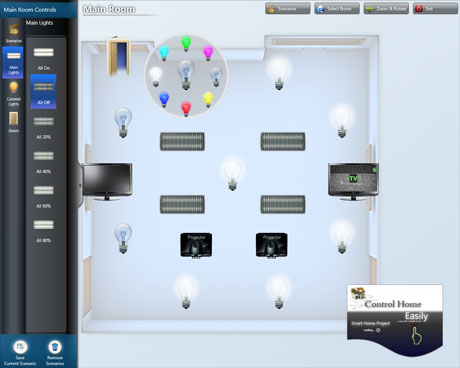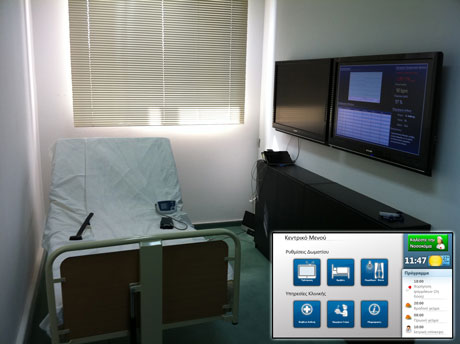by Sokratis Kartakis and Constantine Stephanidis
Ambient Intelligence Technologies in the home assist inhabitants in their everyday life, providing environment control, power consumption monitoring and intelligent patient assistance.
The ICS-FORTH Ambient Intelligence Programme is an on-going horizontal interdisciplinary RTD Programme that aims to develop and apply pioneering human-centric AmI technologies for smart environments, capable of “understanding” and fulfilling individual human needs. This Programme constitutes a systematic effort towards addressing socio-technical challenges, by providing natural forms of interaction and access to information. In this context, a wide variety of AmI applications and services have been developed for various environments and domains, including home and everyday living, office work, museums / exhibitions, public spaces, education, and health. These developments constitute showcases for demonstrating AmI technologies in practice and their potential and benefits in different aspects of everyday life and activities.

Figure 1: Control Home Easily application.
In the context of the AmI Programme, a line of research is targeted towards intelligent home environments capable of assisting their inhabitants in everyday life by supporting the pervasive diffusion of “intelligence” in the surrounding environment through various wireless technologies and intelligent sensors. To simulate such environments, a laboratory space has been adapted which integrates various hardware (such as Zigbee, Bluetooth, Wi-Fi, RFID, custom hardware controllers, ) and software technologies, allowing the user to control electrical and electronic devices automatically or manually.
In this environment, a number of experimental control applications have been developed. The first such application, named CAMILE, allows users with disabilities to control lights easily through an accessible user interface. The acquired experience in this context led to the conclusion that the main drawback of developing independent control applications is that the provided solutions are not sufficiently general purpose, as every time a new appliance is installed in the smart environment (eg a new light), the existing application needs to be modified or a new application becomes necessary.

Figure 2: (a) Simulation box with electrical panel and four plugs, (b) application for control and monitoring and (c) circuit for retrieving data wirelessly.
To overcome this issue, subsequent efforts focused on the creation of an abstract application which can control electronic appliances with various interactive devices like touch screens, mobile phones, switches for motor impaired users, etc. A first approach was the development of two tools, named AmIDesigner and AmIPlayer, which have been specifically developed to address the above challenges through automatic generation of accessible GUIs in AmI environments. The disadvantage of this approach was that an expert user was needed in order to design the Smart User Interface that binds the virtual widgets with the real devices through AmIDesigner.
Thus, we decided to create an application that auto-generates User Interfaces based on information provided by the Smart Environment. The Control Home Easily application auto-generates user interfaces and allows users to easily manage the home appliances of every room from inside or outside the home using various interactive units through simple touch. Two versions of the application have been developed, one for large interactive devices, such as touch screens, and one for mobile devices.
The main advantage of this application is that it can automatically identify the smart devices of the desired room and register them with different hardware technologies. On the other hand, Control Home Easily incorporates various hardware technologies such as Zigbee, DMX controllers and devices that use serial protocols. The only overhead for each device is the necessary creation of a user interface element called “widget”. As a consequence, everyone can use the system, integrating each smart device without special software or hardware installation.

Figure 3: Smart Patient Room and touch pad application.
Another important issue in a smart home is power consumption monitoring. Various custom circuits have been created that allow the retrieval of data from the plugs, including voltages and amperes measurements, as well as the ability to control them (wired and wirelessly). These data can be saved and used for statistical processing, and the environment can advise the resident about optimal power usage, as well as providing information about the total cost of power consumption.
Based on the developed control and monitoring applications, simulations of real environments are also being developed. The first such environment is a Smart Patient Room which can be located in a home or a hospital, and allows users to control the environment and efficiently use the facilities of an exclusive nurse, while simultaneously helping the nurse or doctor in their clinical routine. With the use of an application tailored to a touch pad device, the patient can control various devices including lights, window blinds, TV sets and bed position. Additionally, various sensors can measure blood pressure, heart rate, oxygen level and patient’s weight and can create a real time heart graph. This data is available to the patient’s doctor from his office, enabling him or her to monitor the patient’s status at any time.
The applications described above have the potential to facilitate the independent living and everyday activities of older people at home, but also of other home inhabitants, by providing accessible and user-friendly interaction with the smart environment. The new ICS-FORTH AmI Research Facility, due for completion at the end of 2011, will comprise simulated AmI-augmented environments and their support spaces, as well as laboratory spaces for developing and testing related technologies, and will provide an appropriate environment for pilot deployment and longer-term user-based evaluation of the developed AmI technologies under conditions very similar to real life.
Link: http://www.ics.forth.gr/ami/
Please contact:
Constantine Stephanidis
ICS-FORTH, Greece
Tel: +30 2810 391741
E-mail:










